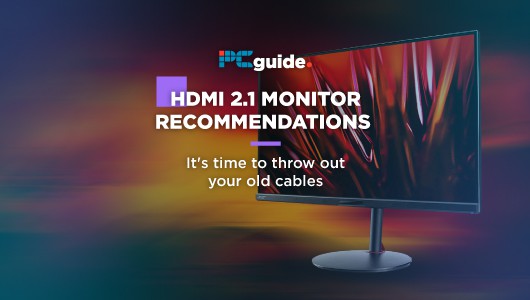Best HDMI 2.1 Monitor in 2022

HDMI 2.1 Monitors are slowly taking over the old, with the standard starting to appear more and more monitors as 2021 carries forward.
HDMI takes the similar method that USB does, by adopting the same look, but altering the insides to meet the new specifications. This can usually be indicated via the sticker stating “ULTRA HIGH SPEED” on the packaging.
Products at a Glance
What is HDMI 2.1?
The new 2.1 standard provides 8K at 60 frames-a-second and 4K at 120FPS, bringing a new level of fidelity for gaming, as well as viewing media. However, to get these new resolutions and extra frames, you’ll probably need a new monitor – or TV – but once you do, you can pump more out of your graphics card and if you’re on the new consoles, Xbox Series X or PlayStation 5, you’ll be able to experience these resolutions on certain games right now.
Unfortunately, that does mean that a lot of the mass of cables you’ve acquired over the last decade or so are going to be completely useless at outputting anything more than 1080p. Upgrading your cables does give you access to ARC and eARC, which is a really neat way to simplify your audio setup by having the HDMI just determine what’s coming through the speaker.
Best HDMI 2.1 Monitor in 2022
- Smooth 144Hz Refresh Rate
- Consoles also supported
- A great baseline for everyone
- USB-C Ports with 65w charging
- 1ms Response Time
- Limited HDR
- HDMI 2.1 is still expensive
A perfect entry point into the HDMI 2.1 ecosystem, the Acer XV282K might be a pricey as an ‘entry-level’ monitor, but it fits the bill for everything you might need to do on your PC. Acer makes cracking monitors and was first out the gate with a bevy of choice, which in some cases usually means a ‘beta’-esque feel for early adopters, but our sister site, WePC, highly recommend it in their review.
While the HDR isn’t dazzling, the HDMI 2.1 port allows for an excessively fast refresh rate of 144Hz, for super-smooth gaming experiences and while the price is high on the monitor for what it provides in comparison to ‘older’ models, this is essentially you securing the future for the next little while.
HDMI 2.1 can provide up to 10K when properly utilized, but as of right now, does at a maximum of 8K simply due to the panels and hardware available. Bringing in your 4K HDMI 2.1 monitor now pretty much puts you ahead of the curve for any future upgrades, especially once the graphics card shortage and electrical shortage come to an end.
Gaming at a higher framerate is also just a better experience overall, having 144Hz isn’t the top end, but having it at 4K with a potential RTX3000 card? That’s basically heaven on a screen.
- Perfect Living Room PC Monitor
- 144Hz for those who need buttery smooth games
- 43 Inches for tonnes of real estate
- Internal Power Supply
- Display Port 1.4 included
- Massive colour gamut
- Tacky gamer aesthetics
- Not true 10-bit colour
- Probably not suitable for a desk
- No 24-fps
It’s massive at 43″, but this giant TV-esque monitor can actually still be used on the PC without much issue. It supports GSync for buttery-smooth gaming but also makes for the perfect addition to those who like to have their PC as their console. Instead of having to deal with the television being a television with your PC, resulting in blurry text or weird issues on the actual PC side of things, this is literally just a straight-up PC monitor at a big scale.
What this wouldn’t be great for is watching movies, weirdly enough. The lack of 24FPS support (or 24p) means your movies and TV shows might come out looking a little strange. Bundle this with the grotesque gamer aesthetics that infest a lot of what Gigabyte does, you can probably guess what the primary purpose of this is for.
Gaming on this thing is absolutely the intended use. Sit back, bask in the rich, deep colours and HDR, while you immerse yourself in whatever world is being presented. I want one permanently for gaming purposes, but if you’re in the office or something and somehow find a way to get this on your desk, you’ll have the fanciest screen for spreadsheets ever.
While I wouldn’t recommend it for content creation, the focus on bringing the largest, best experience for gaming would probably lend itself well to those who are exclusively in web content. The main issue I take with this is that it has all the bells and whistles that a monitor of this calibre should have and then only features an 8-bit+FRC screen. FRC is a method of ‘faking’ 10-bit, while still supplying a fairly accurate colour for the viewer, but is horrible for editing on if you intend to colour grade.
While gaming, you’ll never notice, but on close inspection, the screen flickers between the needed colours it has to hit, which is why it slightly infuriates me when major websites claim it’ll be good for video editing.
- Excessive Support for various HDR Standards
- 1600 Nits of Brightness
- Swivels
- True 10-bit colour
- 120Hz
- Costly
- HDMI 2.1 is only supported the latest graphics cards
- Haloing could occur on real blacks because of MiniLEDs
This is a lot of money and even for professionals – which this is aimed at – it can seem steep. But HDMI 2.1 hasn’t hit regulars BenQ or Eizo’s line of high-end monitors (Eizo do have an SDI option though) and probably won’t until 2022 – at least across the board. So in the meantime, ASUS has stepped up to the plate with a real monitor.
Not only does it top out at a blinding 1600 nits (that’s the term for measuring brightness), but this monitor outputs a true 10-bit colour – no 8-bit FRC here – so to take full advantage of it you will need an RTX 3000 card, Quadro, Blackmagic DeckLink, Teranex or AMD 6000 card.
This makes it perfect for those that are in the colour grading space, while not perfect over HDMI 2.1, coverage of the colour spaces include 98% of DCI-P3 (for the film industry) and 100% of Rec.709 (used pretty much everywhere else) is astonishing. You get what you pay for as they say.
It doesn’t even seem to stop there, as the monitor is perfect for modern workflows, with two Thunderbolt 3 ports in the back of it to alleviate your PC or Mac’s port selection. This is also a great way to utilise Thunderbolt 3’s daisy-chaining technology, allowing you to host either more than one screen or connect a number of devices off the back of it with multiple cables.
Or, as ASUS recommend, plug in the colour grading kit you have via USB-C port that the Thunderbolt design takes on.
The ASUS PA32UCG also runs MiniLEDs, a newer technology being adopted by monitor manufacturers, that provides far more detailed blacks and colours than the regular LED, but is much less expensive than OLED. With multiple lights instead of a massive single sheet illuminating the screen, it effectively ‘switches off’ the ones not currently being used to produce a truer representation of the colour on screen.
Anyone in a professional space will find themselves with more than enough technology to back their projects, even down to swivelling the monitor around to show off progress.
- HDR10+ Support
- AMD FreeSync
- AirPlay 2 and Chromecast inside
- Dolby Vision
- Mainly for consoles
- Expensive
- 'Variable' Refresh Rate might not work out the box
HDMI 2.1 monitors aren’t exactly on the shelves constantly and as such, if you’re in the market for something that can technically support your PC in your endeavor to futureproof yourself, you’ll find that VIZIO currently has the ‘best bang for the buck’ screen you can get with HDMI 2.1 onboard. Not only that but it comes with AirPlay and Chromecast for media playback, which is always handy to have.
At the end of the day, this is simply a TV with some fancy features built-in. It won’t play your games at a high refresh rate, but it will make them look good! This is more for those that don’t particularly care for a higher refresh rate but want their things to look at their best.

Best HDMI 2.1 Monitor in 2022
Our Verdict

Best HDMI 2.1 Monitor in 2022
The Acer XV282K is a great offering, featuring 144Hz and HDR, it makes for a great gaming experience and also, just a generally lovely screen for any office work you might have. The thin stand and base won’t take up too much room on your desk either, plus, if you’re someone who uses a USB-C device, the 65 watts of charging out of the port is surely enough to convince you that this monitor is trying to do it all and does it pretty dang well.





